October 2017
STAR Newsletter
October 2017 edition
Contents:
- Extremely low pT J/ψ and e+e- continuum production in violent hadronic collisions
- From the Spokespersons
- Software & Computing Update
- STAR at DNP
- STAR arts
A note from the editor: as a collaboration-wide communication tool, this newsletter is set up to allow comments (subject to moderation against abuse), and all STAR Collaborators are welcome to do so! Please keep in mind that some content (including all comments) may be considered internal to the Collaboration and only accessible when logged into Drupal. Documentation is available here.
Extremely low pT J/ψ and e+e- continuum production in violent hadronic collisions
(Shuai Yang - BNL,
Wangmei Zha - USTC)
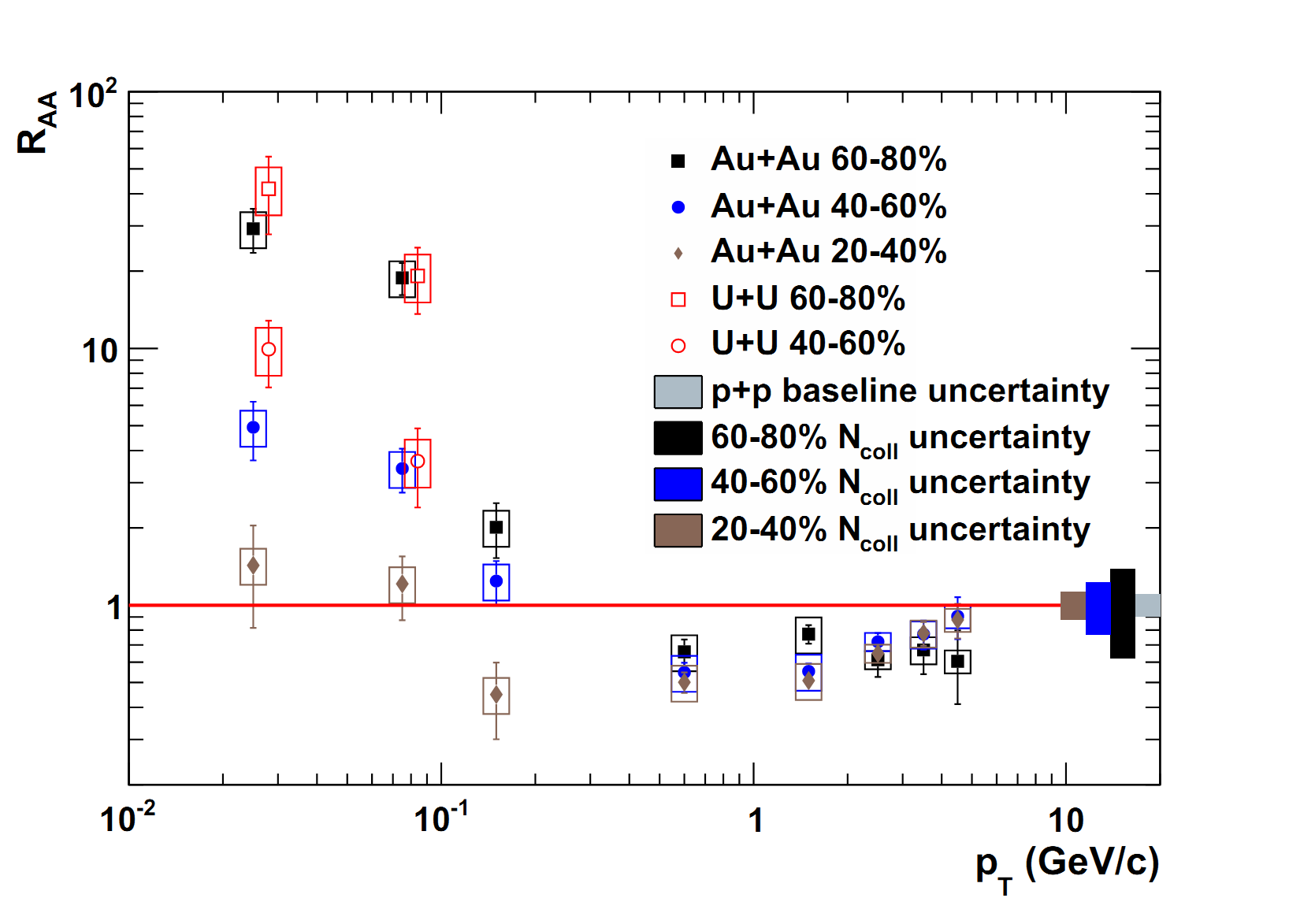
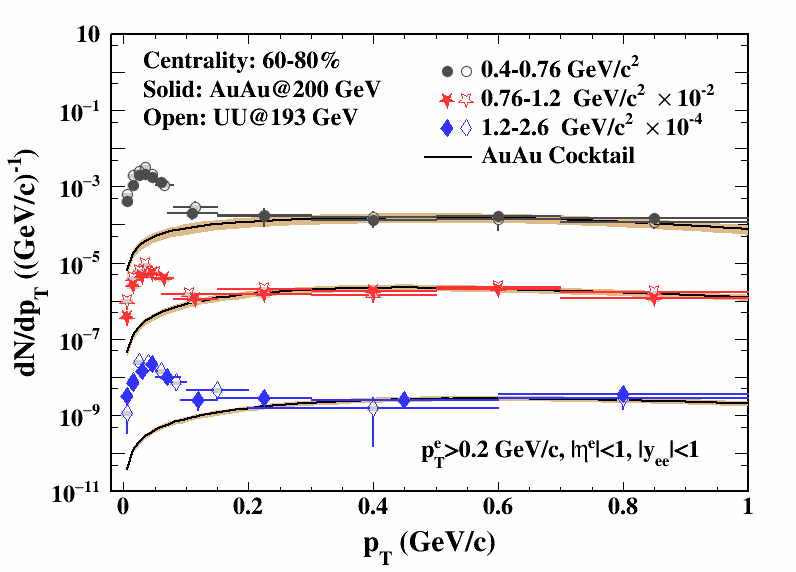
Top: J/ψ RAA vs. pT for various Au+Au and U+U centralities
Bottom: The e+e- pair pT distribution within STAR's acceptance for three mass ranges in 60-80% central Au+Au and U+U collisions
If the coherent photonuclear production was the underlying mechanism for the observed J/ψ excess, the photon-photon production would be there and contribute to the e+e- pair production. The measurements of mass differential e+e- pair production at very low pT , thus become necessary to verify this and should further constrain the details of the photon interactions in violent hadronic collisions. Through the measurements of e+e− pair production at pT < 0.15 GeV/c in Au+Au collisions at √sNN = 200 GeV and U+U collisions at √sNN = 193 GeV, the e+e- pair yields in a wider mass region are found to be significantly enhanced with respect to known hadronic contributions in 60-80% collisions in both collision species. Strikingly, the entire observed excess is found below pT ≈ 0.15 GeV/c and the excess yields show much less significant centrality dependence than those from hadronic sources. Compared with theoretical calculations incorporating with coherent photon-nuclear and photon-photon contributions to the e+e− continuum, the contributions from the photon-nuclear process to the observed excess is found to be negligible while the photon-photon process becomes a dominant contribution and can describe the observed excesses reasonably well.
The observed J/ψ and e+e- continuum excesses at extremely low pT are very likely linked to photon interactions in violent hadronic A+A collisions, which challenges the conventional understanding of photon interactions and will stimulate further experimental and theoretical investigations.

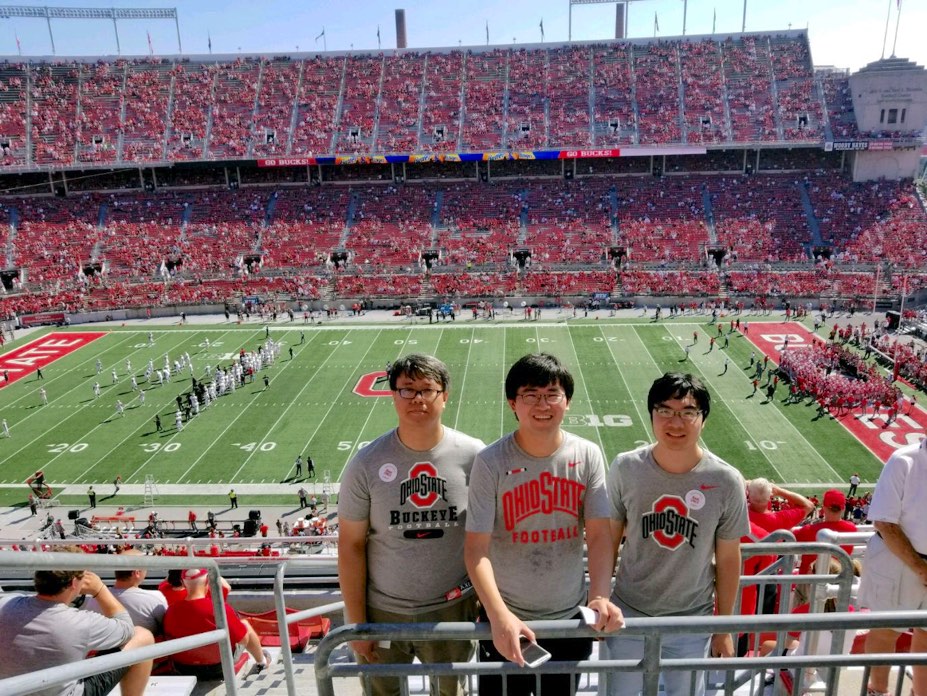
Left: J.H. Lee connecting back all the TOF utilities after replacing TOF tray #90. The TPC sector #20 on the left is the new iTPC sector without any utilities yet.
Right: Visiting students treated to an OSU Buckeye football game! Mike Lisa has set the bar really high on hosting visiting students, WAY TO GO!
(Zhangbu Xu - Co-Spokesperson)
September and October have been two more very productive and busy months.
We had a successful DOE review on iTPC on September 26th and 27th. The first iTPC sector was installed as sector #20 on October 5th, 2017. To celebrate the 20th year since the STAR TPC recorded its first cosmic ray track and installation of the first iTPC sector, we are preparing a photo session during the analysis meeting on November 3rd at 3:45PM (agenda available here). During most of the STAR collaboration meetings or analysis meetings at BNL, the STAR detector has been in operation and not accessible to a large crowd. This November, the STAR detector will still be open without the concrete shielding, and some of the sectors on the east side have been stripped off of electronics and the cooling manifold for the installation of the first iTPC sector. You will be able to see the clean tent and insertion tool in the Assembly Hall, and the STAR detector with the first iTPC sector in the Experimental Wide Angle Hall. The last time that the Collaboration took a picture with the rolled-out detector was almost 20 years ago when I was close to PhD graduation. For many, this is a once-in-a-lifetime opportunity.
In the last few days, I have been at the experimental area, helping with the operation of the detector together with Bill Christie, Bob Soja, Robert Pak, J.H. Lee, Shuai Yang, Robbie Karl, and other C-AD technicians. I have observed the roll-in of the detector with the hydraulic system, pulled bad TOF trays out and replaced with spare trays, heard about how to prevent cooling water leaks, and discussed in details how the Global Interlock System works. I would look up at the detector complex and still be amazed at the discoveries this modern marvel has enabled us to make. It has been a while since I have felt so connected to the experiment. It reminds me why I enjoy being a scientist and love what I do. Thank you Bill and Bob for giving me this opportunity.
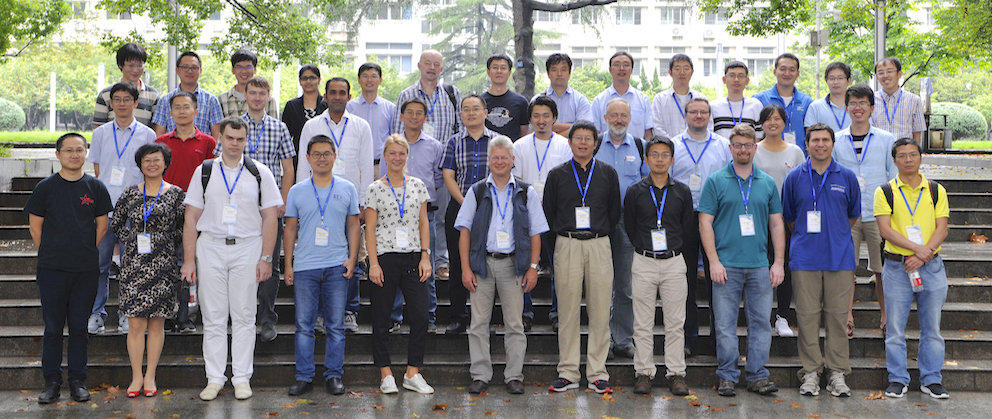
Attendees of the second STAR-CBM Workshop, in Wuhan, China.
STAR Management has formed a Blind Analysis Committee chaired by Jim Drachenberg (Lamar):
Charge for the Blinding Committee: the Committee is requested to document recommendations on procedures for how STAR should implement a blind analysis for the CME-related studies on the upcoming isobar data. The committee should work in conjunction with the CME focus group as necessary. The committee should consider...and a CME Focus Group chaired by Jiangyong Jia and Paul Sorensen. Meanwhile, we have requested C-AD to alternate the Zr and Ru collisions in frequent intervals, and the agreement is to have the switch between these two isobar collisions at least every two days. Jamie Dunlop has convened a panel in assessing the risks and a report to the ALD is in preparation.The committee should aim to finish its deliberations for presentation to the management by early January. The management aims to seek endorsement by the Council at the January 2018 collaboration meeting.
- The techniques used to blind the data and who should be keeper of the unblinding rubric
- Which analyses should be blinded and what is expected from collaborators who plan on contributing to such analyses
- What are the minimal conditions that must be met before an unblinding can be considered; what procedure and timeline should the unblinding procedure follow
- What steps, if any, can be taken in the analysis after the unblinding; how do we then proceed to publicly announcing the data
Please join us in congratulating our fellow Collaborator Ernst for having been selected as a 2017 APS Fellow:
Sichtermann, Ernst Paul [2017]Well-deserved recognition!
Lawrence Berkeley National Laboratory
Citation: For leadership and contributions to the understanding of nucleon spin at RHIC and to the efforts on a future electron ion collider.
We have a few rotations of the convenorship, and the current list is here. Thank you for all your efforts and service to the collaboration.
Lastly, Quark Matter 2018 abstract deadlines are upon us: Abstract to the PWG lists: Nov 13th; Startalks: Nov 27th; Conference: Dec 11th.

The STAR geometry with a full array of (rectangular, purple & green) ETOF module triplets arranged azimuthally at the far end, integrated for simulations (open the image separately to see full resolution)
(Gene Van Buren - Software & Computing Co-Leader)
As usual, the Software & Computing Team has been active on numerous fronts lately. One such effort can be readily visualized in the image at right: working together with our new Collaborators from the CBM Experiment who are involved in STAR's ETOF project, the ETOF modules have been integrated into the STAR simulation geometry in preparation for their installation prior to the upcoming Run 18. This was an outcome of the Team's participation in last month's CBM-STAR Workshop, already noted in the Spokespersons' contribution of this Newsletter. It was a valuable opportunity to establish communications across the groups and gain understanding of what steps are necessary to have a subsystem that can be analyzed within the STAR computing environment on Day 1 of Run 18. Our hope is that there may be other areas of constructive cross-collaboration efforts even beyond the ETOF.
Another significant endeavor of the S&C Team has been to bring misalignments into STAR simulations. This was determined to be a critical requirement for proper physics-caliber embedding studies with the HFT, and the path taken to deliver this through modification of the existing STAR simulation framework was pursued with the endorsement of the HFT subsystem group. Numerous validation checks and quality assurance tests are now culminating in the final integration of misalignment machinery (see You do not have access to view this node for a recent status update), and this, along with detector response simulators for the HFT components, will be a primary topic of the You do not have access to view this node at the upcoming STAR Fall 2017 Analysis Meeting. Attention is also turning to STAR subsystems beyond the HFT for which the misalignments can be usefully included, such as the TPC, BTOF, and also ETOF (this was presented at the CBM-STAR Workshop, for example).
The Team is working on numerous topics in preparation of support for Run 18, and recently performed an annual self-critique of support efforts & experiences from the last Run. Coordinated efforts will be necessary to be ready for the iTPC, EPD, and already-noted ETOF. Please also be aware that downtime for computing resources at BNL associated with network re-shape and operating system upgrades are coming (don't be caught by surprise).
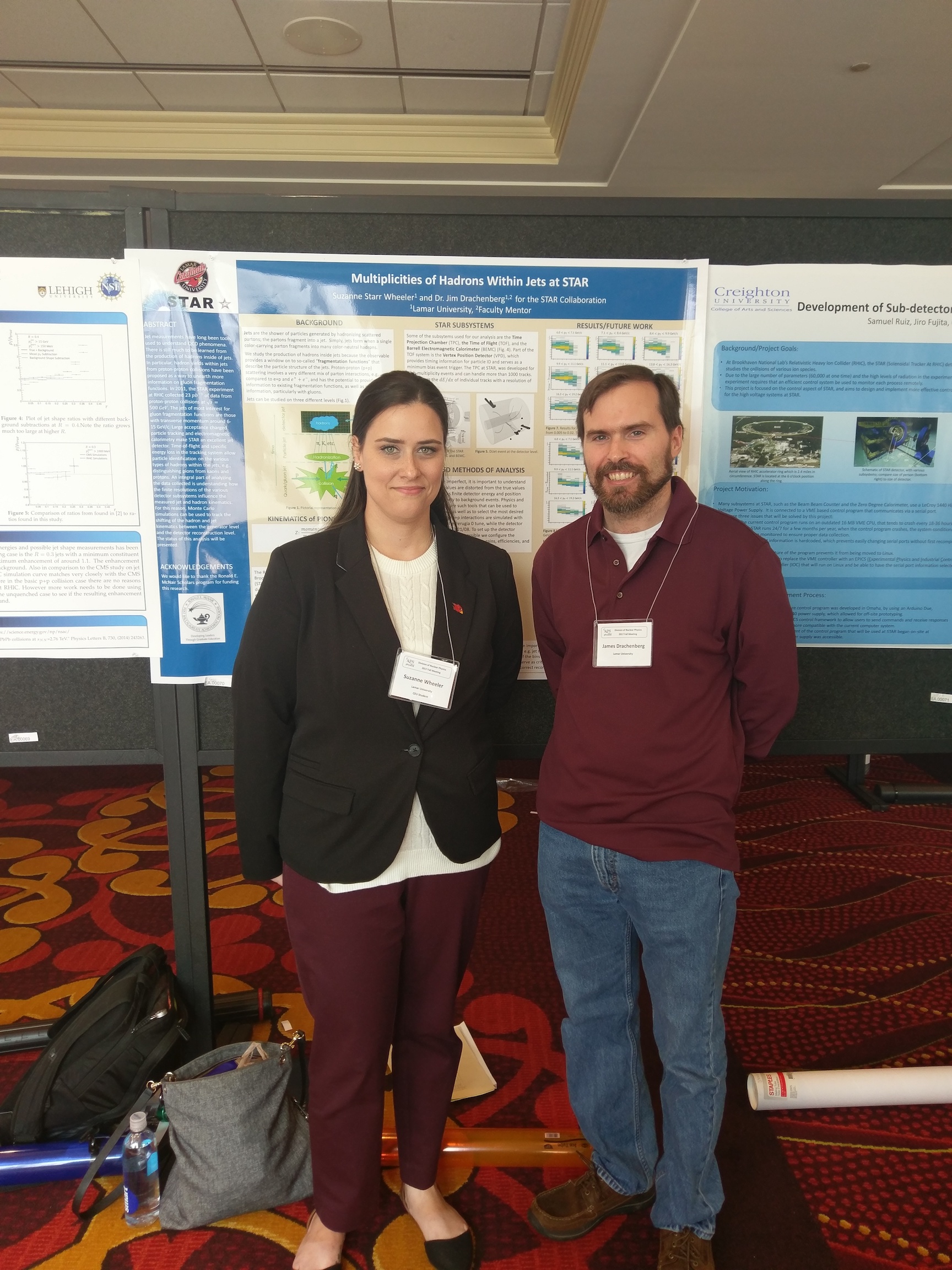
Suzanne Starr Wheeler and Jim Drachenberg of Lamar University
(Helen Caines - Yale)
October 25th-28th saw many of us in Pittsburgh, Pennsylvania for the annual fall DNP Meeting of the APS. The STAR/RHIC program featured center stage in the opening plenary session with the first three speakers showing data from RHIC. The key note speaker was Nobel Laureate David Gross discussing elements of QCD including the discovery of the “Quark Gluon Liquid”, and urging continued exploration of the phase diagram. Next up was successful Venture Capitalist and STAR alum Dr. Mike Miller with his great talk "Physicists in the Wild". His Ph.D. reported STAR's now iconic di-hadron "jet quenching" results, and he spent his first Post. Doc. position at MIT on the STAR Spin program with Berndt Surrow. He encouraged everyone to take on small side projects if they seemed exciting, but to do your research before starting a new endeavor, as he said "a month in the lab can save you an hour in the library" (Mike attributes the quote to Hamish Robertson). Next up was Christine Aidala who described recent progress in the Cold QCD program at RHIC. Other excellent talks were given by our collaborators throughout the conference.
Always a highlight of the DNP meeting is the CEU Poster session. Undergraduates from Creighton, Lamar, Lehigh, Rutgers, UCLA, Valpariso, and Yale presented their STAR analyses and simulations on topics ranging from enhanced slow controls programing, EPD construction, EMC calibrations, and jet and CME studies.
Included here are a few photos from the event.
P.S. If you haven't done so already please upload your slides to the STAR presentations webpage.
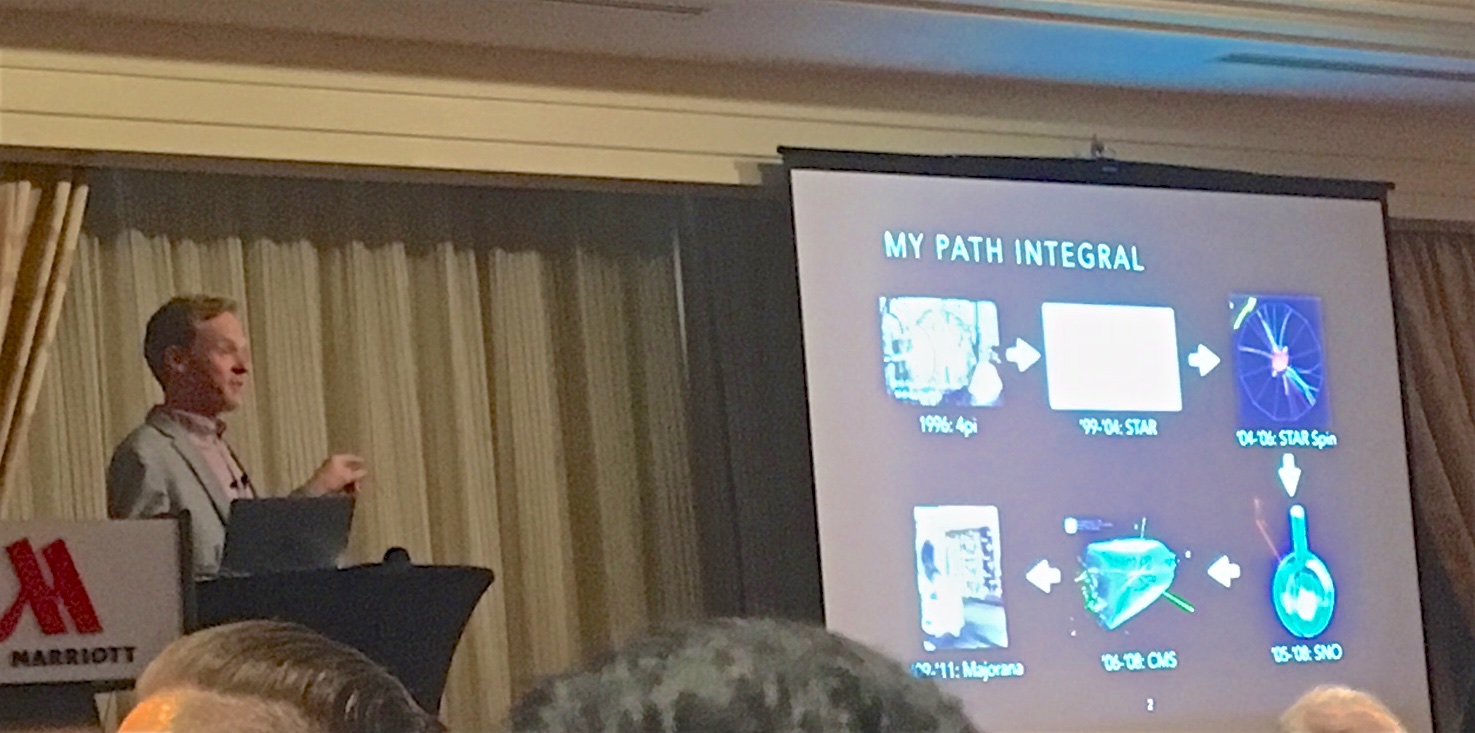
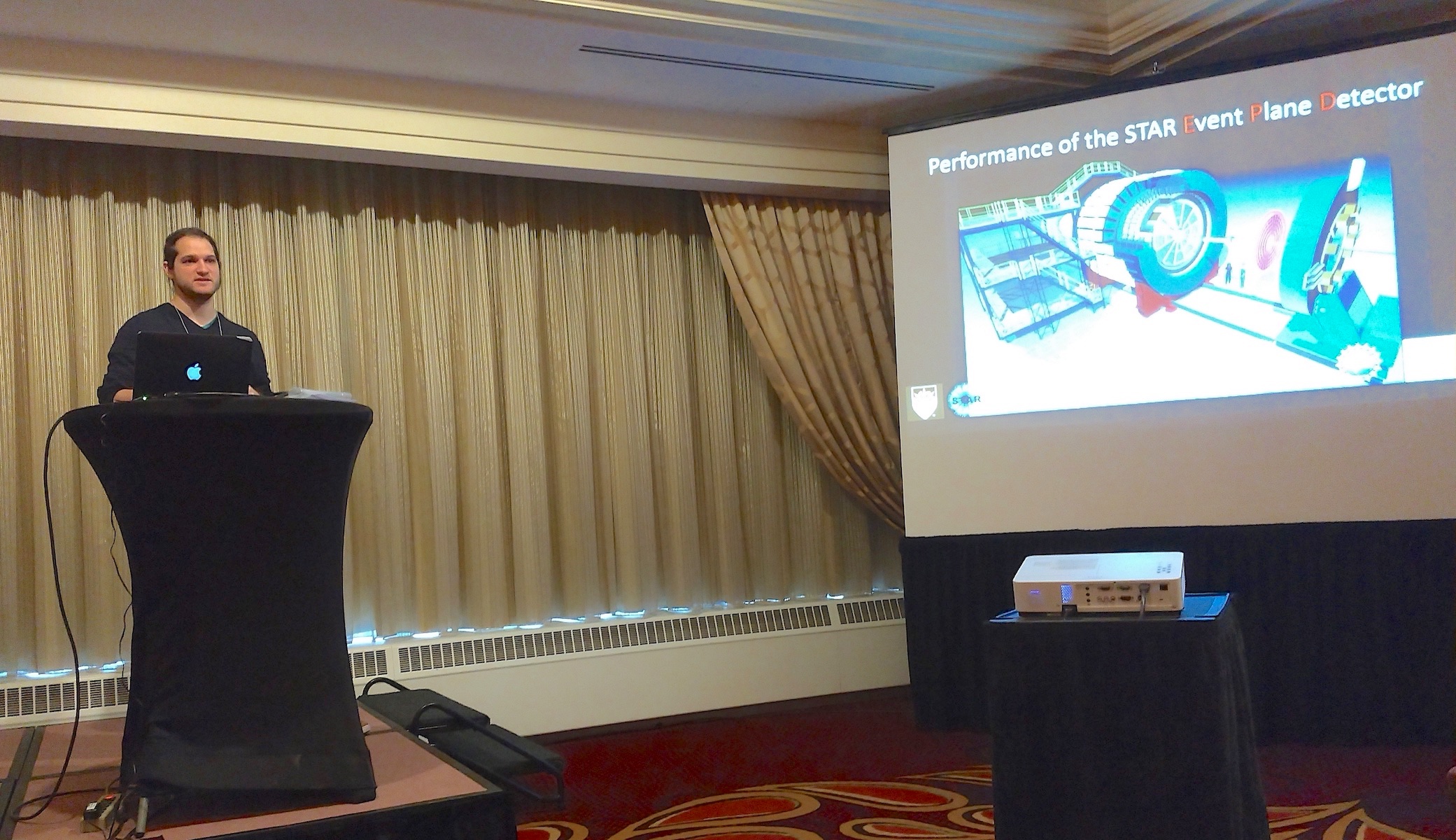
Left: Mike Miller, former STAR Collaborator
Right: Justin Ewigleben of Lehigh University
STAR arts
(Jim Thomas - LBNL)
This is a recently introduced feature we're trying with the STAR Newsletter for Collaborators to contribute something creative/artistic that relates to STAR. This could be a really cool looking graph generated from some analysis, or a striking photograph. The idea is akin to the "Back Scatter" feature of Physics Today (example), or the Picture of the Month of CERN Courier (example). Please feel free to have fun with this and consider making a contribution yourself for the next edition!
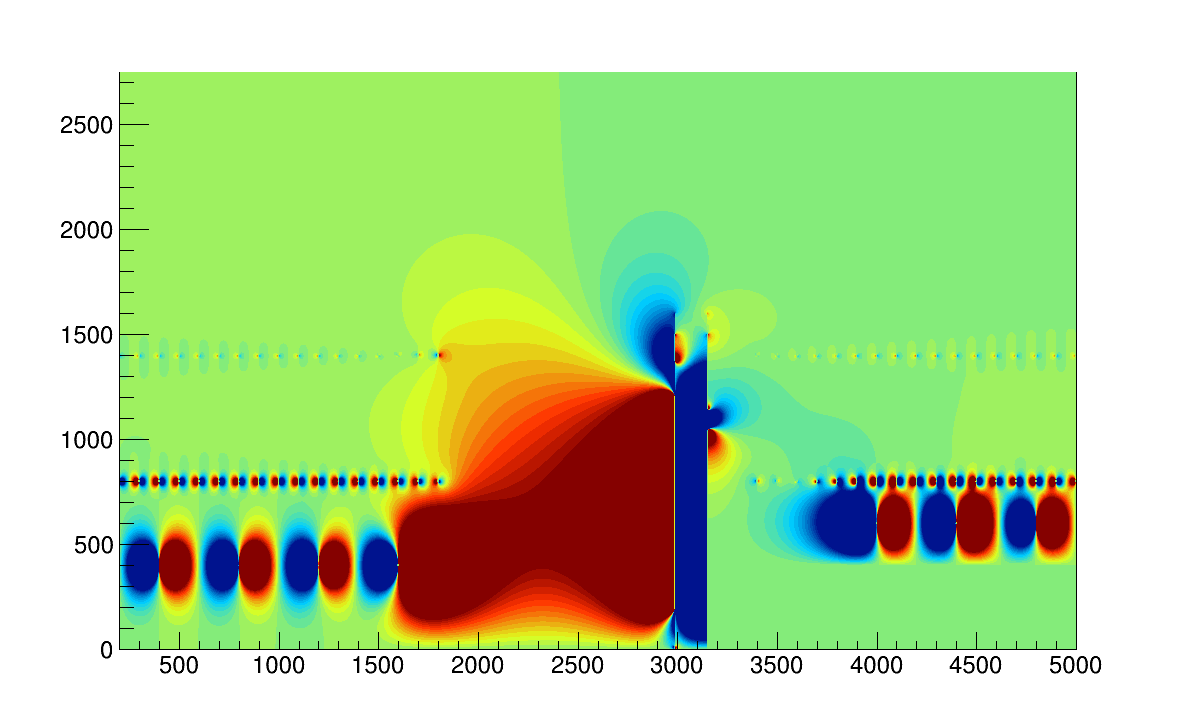
Simulated transverse component of the electric field in the multi-wire region of the STAR TPC with the iTPC geometry design for an electrically biased wall whose intent is to eliminate the back-flow of ions from both the inner (right) and outer (left) TPC known to many in STAR as the infamous "GridLeak"; while anode and cathode wire layout re-design should eliminate the back-flow for inner sectors, simulations have been critical in finding a solution for the outer sector contribution without actually doing anything at all to the outer sectors themselves